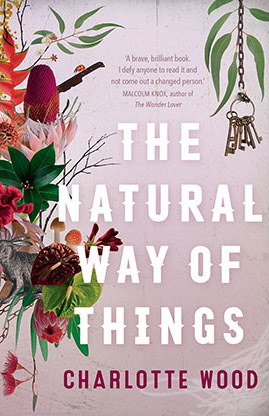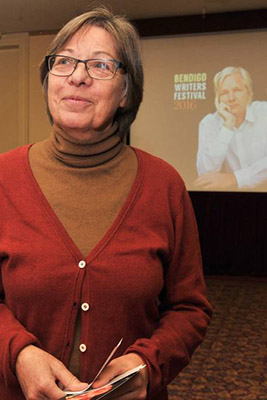Listen to the Sirens: The Natural Way of Things by Charlotte Wood
Charlotte Wood’s fifth novel The Natural Way of Things is a virtuoso performance, plotted deftly through a minefield of potential traps, weighted with allegory yet swift and sure in its narrative advance. As an idea for a novel, it’s rich, and to achieve that idea the writer has been courageous. Her control of this story is masterful.
There is much to intrigue and draw a reader in, starting with the anodyne and ambiguous title. The natural way, or the natural order, is as much a religious idea as it is a biological one, and, like Lucretius in his sublimely revolutionary De Rerum Natura, Wood’s novel suggests ‘Hell is right here, the work of foolish men’. The novel invites us to think about the difference between sexuality and gender, between femaleness and femininity. This is what feminism in the 1970s discussed with such vigour. Since then, that discussion has swerved, understandably, towards the fight for women’s rights, political, economic and social. While Margaret Atwood’s The Handmaid’s Tale (1985) imagined a future world faced with a fertility crisis, and government intervention that returned women to subjugation through financial and social dependence, in Wood’s fictional imagining, the mechanism of punitive control is simply to remove those whose sexuality has become a provocative inconvenience to powerful men. It’s galling, but is it impossible?
The novel is set somewhere in the Australian bush, possibly west of Sydney, in a place that appears to be an abandoned sheep farm but with elements that also suggest it has been used as some kind of institution or detention camp. The opening scenes are brutal. Ten young women find themselves incarcerated under the surveillance of two young men and a woman who is a sham-nurse. These three casually nasty guards are under instructions from an agency named Hardings International (‘Dignity and Respect in a Safe and Secure Environment’) to shave the women’s heads, dress them in weird outfits of harsh cloth and vision-restricting bonnets like beaked wimples, chain them together when they are put to hard labour outside, and lock them in dogboxes overnight. The women are all, they realise quite quickly, linked by sexual scandal. One is the victim of a football-buddy pack rape; another the inconvenient lover of a high-profile politician; there’s a woman whose partying on a cruise-ship led to her being assaulted, another who was a contestant on a TV talent show until it came to light the show’s producer had singled her out for sex.
Yes, the story is freighted with what can be understood as references to people and events we have read and heard about in often salacious detail, each instance accompanied by debate about women’s roles, women’s depictions, women’s behaviour and women’s treatment.
It is not only the sex that links the group of persecuted women in The Natural Way of Things: it is the fact they were blamed for it. As long as the less powerful player in any sex scandal (usually a woman) is still accessible for follow-up recriminations and media exploitation, she is an embarrassing risk to someone who wants the notoriety to blow over. What if there were a dependable agency that could be engaged not just to remove the female from the playing field, but also to factor in a satisfying bonus, ensuring she is humiliated and punished, physically and emotionally. Could there exist men and masculinist institutions that would be able and willing to pay for such a ‘service’?
Surely an impossible place, and surely an absurd scenario, but Wood has made sure there is too much that rings true in the construction of this imaginary scenario for it to be dismissed simply as fantasy. If we can accept the premise as possible, even though, we would hope, unlikely, we can then head off inside the electric fence with the writer and her women, into some very risky territory. Questioning women’s responsibility in representations of sexuality, let alone in actual sexual assault, tends to draw angry backlash. Helen Garner’s The First Stone (1995) was furiously debated, when she wrote in a way that some readers thought was as much in sympathy with the man accused of sexually exploiting his students as with the younger women themselves. Since then there has been an inching forward towards an understanding of how to balance blame and responsibility so as not to perpetuate female victimhood – but the discussion nevertheless continues to be belligerent when it first plays out in conventional and social media.
By fictionalising victimised women, creating them both as a type and as individuals, Wood gives herself room to debate the blame vs responsibility question with some freedom. United by their past treatment and by their current deplorable situation, they respond in very different ways, and if lessons are to be learned across the nine or so months of this story’s course, the women are all differently equipped to learn them. The Natural Way of Things makes it clear: there are females who are every bit as sexist (and masculinist) as males. And yet, there might also be a point at which shared female experience does produce what is called the sisterhood. (How different are the connotations of that word from those evoked by the word, ‘brotherhood’.) Watching the guard Teddy with Nancy, employed by Hardings as a kind of nurse but barely able to look after herself, the women decide,
He was disgusting, like all men. It was men who started wars, who did the world’s killing and raping and maiming.
As a group, they ponder briefly what it would be like if women ran the world, until one says, ‘But I like men… Not these ones, obviously.’ And then, too, they agree there’d still be Nancy, and also stumpy, spotty, cunning Hetty, the ‘Cardinal’s girl’ who decides early on that they have been chosen as contestants in a reality TV show, ‘Like The Bachelor, but more edgy’. The ebb and flow of the group’s relationships, as the months go by and their physical survival becomes more desperate, enriches the story’s progression, so that even though we are waiting, with the characters, to gather information about what is happening here, and as the tension gradually builds towards the expectation of a climax to the ordeal, as with any good suspense story it is characters and their interaction that must matter to the reader.
Of the ten young women, all barely out of their teens, two are singled out for development and we are given brief glimpses of their past lives back into childhood. It is through their eyes we see what is happening in this nightmare prison. Yolanda is the sexy girlfriend of a footballer, victim of pack rape and consequently seen as that mythic monster, a vagina dentata, personification of the lust which traps and soils, even destroys, heroes. Verla is the educated junior staffer, swept up in an adulterous love affair with the politician for whom she works. It’s Yolanda’s boyfriend and brother who orchestrate the drugging and abduction that deposits her in this detention centre for women whose sexuality has become a nuisance to someone powerful. In Verla’s case, it is a woman in the politician’s office who orchestrates the disappearance, and it is on that woman that Verla focuses her homicidal fantasies as the months go by.
Each of the women finds a way to respond to this hellish place. Yolanda, who is the most conventionally desirable, undergoes the most radical transformation, a vividly described sloughing off of the femininity that caused her such grief and a reclothing in animal skins, animal nature, animal freedom. She becomes hunter, not hunted, and no longer the trap but the setter of traps. Wood asks questions about what it means to be female, and how essential is that to femininity. Is killing a wounded creature as possible for a woman as a man, and is it more courageous, therefore more compassionate, to do so?
Most of the others cope as best they can, holding on to the hope they might be restored to their former lives, with perhaps less naïve acceptance of the way things work. That hope is vain, Wood suggests. This is not romance fiction. That the plot is outlandish is less risky for the storyteller than whether the psychological behaviour of the characters is convincing. We know they are all very young, and also not much used to independence of thought or action, so their responses, particularly in the final scenes, are horribly (and even humorously) credible. Verla, into whose mind and emotions we are given the most perspective, is the character most likely to invite readerly sympathy (and thus identification), and she is the one with the most to lose. Her education and middle-class comfort put her at odds with the experience of the others, and she has more to learn about what she thought was the way the world works for pretty young women with brains.
When Wood puts the summary judgement of Verla – ‘Oh sweetie. You need to know what you are’ – into the mouth of pathetic, irredeemably misogynist Boncer, the whole vast plain of inquiry about femaleness and femininity opens up for the reader. It then shuts back down again, a prison door slamming, as the women are chained like abused dogs and shown how completely they are trapped in this place and in the Boncer-view of things. Both Boncer and his fellow guard Teddy would be caricatures, one a pimply knuckle-dragging creep and the other a vain self-obsessed hippy, if it weren’t for moments of powerful detail. They don’t develop as characters, in the sense that they might learn anything, or change their essential selves, but they do have to adapt to the circumstances in which their own roles gradually change. Horrible to say, but what happens to Boncer and Teddy is satisfying, in the way that moral tales can provide a sense of relief that justice might prevail. The portrait of Teddy will be much enjoyed by anyone who has ever done a yoga class on the mat next to a narcissistic tempeh-addicted super-male. As a stereotype, Wood nails him with that same groan-inspiring humour.
What Yolanda and Verla think, what they do and how they respond to what has happened to them, has to make sense to a reader, if this novel is going to work beyond allegory, or as more than a storified essay about misogyny. There is a sketchiness to the descriptions of what happens and the women’s response, because this is a story grounded in the events, so that everything is done with economy, from characterisation, to scene-setting, to backgrounding. This means there is an occasional scratchy quality both to the prose and to the story, particularly early on when the reader has to be very alert in this strange place, where we have landed even more ignorant of why and how than are the ten women. And questions about the feasibility of things such as an electric fence surrounding such a vast expanse of land, or a woman slinging rabbit traps around her waist in a clanging belt (surely too heavy and cumbersome), or the appearance of joy-riders in hot-air balloon in such a remote location, might slow or puzzle the reader a bit, as the story races along. Wood’s novel is so allusive but also so stringently and methodically plotted, the niggling questions about such things as where mushrooms grow can be put aside, although they may exercise the tolerance of a reader attuned to realism.
This is offset by Wood’s use of imagery and allusion. While there is an occasional clumsiness to this, such as when pubic bones ‘peep’ (the women are lying back in water), Wood has steeped her text in sensual and evocative literature, and that has grounded her story in a rich earth. Walt Whitman’s poetry literally interleaves the story, with Verla remembering lines from Leaves of Grass, given to her by her lover. She holds on to that shared pleasure to help her through the confusion of her ordeal, clinging to the lines of poetry to remind herself she is, or was, loved. What is eventually revealed to Verla through her reverence for Whitman’s sensual, mystical, provocative and seductive poetry provides one of the novel’s peak moments, a climax in the thrilling final pages. She eventually plucks a line of that poetry from its context in the mighty “Song of Myself” – You can do nothing and be nothing but what I will infold you. Suddenly, finally, it means something else to her – a statement of uncompromising masculine certitude. The shift is disorientating. It challenges us to revise what is, until then, an easy acceptance that Whitman’s magus pronouncements are unassailably gospel.
In fact, occluded beneath the glories of Whitman’s homoerotic eloquence, there may be other writers and poets crowding behind Wood and gently, insistently, pushing her forward. Be a mushroom, Sylvia Plath might be telling Wood and Verla, be one of those who ‘Overnight, Very whitely, discreetly, Very quietly’, nudge their way to a fair share of the light and air, who get a foot in the door on their slow way to ‘inherit the earth’, as the Plath poem tells us. In The Natural Way of Things, the first sighting of mushrooms as autumn progresses and the rains come, is described at a moment when Verla and Yolanda find a communion in their despair:
out there in the blue dusk, the cicadas shimmer and the mushrooms push their white butting heads against the earth, and the horse treads its great hoofs into the soft black soil.
The horse symbolism, masculine and powerful, links to Verla’s later realisation when she finally understands her reading of Whitman as her own blind yearning for a lovers’ equality. Verla does, sort of, ‘become mushroom’, to borrow a Deleuzian concept, gathering them obsessively, but also fascinated by what they might enable her to do. This novel, while bleak in its assessment of the current state of misogyny, does end with a foot-in-the-door scenario of redemption or renewal for at least some of the women, and so seems to endorse the hopeful pathos of Plath’s Biblical echo.
As tension rises inside the compound and some kind of showdown with Boncer seems inevitable, Wood turns directly to the reader and asks, ‘What would people in their old lives be saying about these girls?’ It is a moment when the writer seems to suggest she knows it required a suspension of disbelief to follow her behind the electric fence; her use of the conditional ‘would’ is repeated as she challenges the reader to understand the logic of this absurd scenario.
Would it be said they were abandoned or taken, the way people said a girl was attacked, a woman was raped, this femaleness always at the centre, as if womanhood itself were the cause of such things? As if the girls somehow, through the natural way of things, did it to themselves. They lured abduction and abandonment to themselves, they marshalled themselves into this prison where they had made their beds, and now, once more, were lying in them.
Until now, Wood’s novels might be described as contemporary realism. In her previous two, Animal People and The Children, in familiar suburban settings people’s emotions are set against ordinary events, the slow death of a parent and how it brings together a family, first physically, then emotionally, a day-long description of the unremarkable turmoil in the emotional landscape of a nice man who recoils from commitment. Her writing in these earlier novels is plain but not flat, giving the reader a reliable point of view from which to view the characters, even as you are provided with opportunities to make moral judgements about them. In The Natural Way of Things, Wood’s writing is urgent, bouncing with energy, the subject-matter and the plot demanding and allowing the writer to play boldly with imagery: a grotesque doll with ‘battle scars’, the terrible omen of a wounded male kangaroo, a hot air balloon, ‘an enormous pleated bulb in the clear brightening sky’.
Despite, or even because of, the moral and social ambiguities beneath the surface of this provocative novel, Wood’s book may not necessarily escape a finger-pointing backlash from those who want either to see the writer as a misandrist feminist or, on the other side, a betrayer of the sisterhood. But the strength of her novel is the confidence with which she steers between these Siren dangers, to refer to one of those culture-defining myths that show able-bodied men in danger from feminine evil. A novel such as this is telling all readers it’s time to find a better way to go forward than having male persons stop up their ears and row on by.







